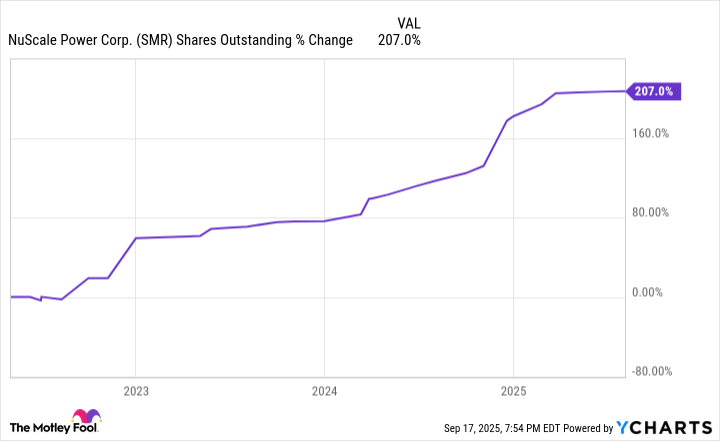
In a world where demand for electricity rises as fast as a teenager’s hopes on their first day at a new job, the U.S. has decided that nuclear energy is its knight in shining armor. The government, in its wisdom, wants nuclear power to multiply like rabbits, growing from 100 gigawatts to 400 gigawatts by 2050. AI data centers, apparently, are going to need a whole lot of juice to keep their servers warm. So it goes.
Enter NuScale Power, a company whose mission is to revolutionize the world of nuclear energy with a small and, allegedly, scalable reactor design. This isn’t just any reactor, mind you; it’s one with the power to reshape the energy landscape. The stock? It’s gone up 300% in the last year, and the company is now worth over $10 billion. What a ride.
But where will NuScale Power be five years from now? Let’s take a look. If you don’t mind facing reality while we do so.
The Only Approved SMR Design. So Far.
NuScale stands out from the crowd in the world of small modular reactors (SMRs). It holds the only approved design by the Nuclear Regulatory Commission (NRC), a body whose approval process is less “quick and easy” and more “we’ll get to it eventually.” NuScale’s reactor design is modular, meaning you can stack them up like Lego blocks if you need more power. That’s a lovely thought. In 2020, the NRC gave them a thumbs-up, and a few more followed after that. So, surely, they’re ready to go, right?
Each reactor can generate 77 megawatts of power. If the design catches on (a big “if”), NuScale could be selling dozens of reactors each year, raking in millions-if not billions-just from sales and maintenance contracts. Sounds promising, right? Well, don’t break out the champagne just yet. You see, they’ve never actually built one. Not a single reactor. Not one. But let’s stay optimistic. Or not.
Nothing to Show for It
So why no projects in the pipeline, NuScale? Their SMR design has been approved for years, but still, there’s not a single large-scale project in sight. Sure, they’re flirting with RoPower, a Romanian utility, but it’s a pretty weak flirtation. There’s no commitment, and the revenue? Almost non-existent. And then, of course, we had the whole Utah thing. A planned project was canceled in 2023. You see, delays and cost overruns happened. And, of course, those things always happen when the hype train is rolling. So the project was canceled. The Utah utility was apparently not interested in losing money on a promise that still can’t be fulfilled. So it goes.
Now, NuScale doesn’t have a single confirmed customer. Not one. All those potential buyers who were eyeing Utah must be shaking their heads, thinking, “Maybe we’ll wait for the cost overruns to go away before we start getting excited.” But as long as they don’t secure a contract, they’re just another company with a big idea and no paycheck. No revenue. No profits. So it goes.

Where Will NuScale Power Be in 5 Years?
In the past year, NuScale’s stock has risen, and its market cap now sits at $10.3 billion. A lofty number. But, and here’s the catch, they’re still a company with zero revenue. A $10 billion market cap for a company that has nothing to show for it? That’s some high fantasy right there. This is a company with a design that’s “approved” but not a single project under its belt. The stock price reflects some naive optimism that someday, someone will buy one of their reactors. But five years from now, the stock will likely be much lower. A startup with no revenue at an inflated valuation is a recipe for disaster. So it goes.
NuScale Power and other nuclear energy stocks may talk a big game, but talk doesn’t pay the bills. Five years from now, they might just be another cautionary tale in the annals of investment dreams gone wrong. It’s a nice idea, but in the end, that’s all it is: an idea. So it goes.
But who knows? Maybe they’ll prove us wrong. Or maybe, like so many before them, they’ll just be another footnote in the ever-growing list of things that never quite worked out. We’ll see. 🥴
Read More
- Deepfake Drama Alert: Crypto’s New Nemesis Is Your AI Twin! 🧠💸
- Can the Stock Market Defy Logic and Achieve a Third Consecutive 20% Gain?
- Dogecoin’s Big Yawn: Musk’s X Money Launch Leaves Market Unimpressed 🐕💸
- Bitcoin’s Ballet: Will the Bull Pirouette or Stumble? 💃🐂
- SentinelOne’s Sisyphean Siege: A Study in Cybersecurity Hubris
- Binance’s $5M Bounty: Snitch or Be Scammed! 😈💰
- LINK’s Tumble: A Tale of Woe, Wraiths, and Wrapped Assets 🌉💸
- ‘Wake Up Dead Man: A Knives Out Mystery’ Is on Top of Netflix’s Most-Watched Movies of the Week List
- Yearn Finance’s Fourth DeFi Disaster: When Will the Drama End? 💥
- Ethereum’s Fusaka: A Leap into the Abyss of Scaling!
2025-09-21 17:02